
8 Descending pitchers
I recently went on a wine safari of Switzerland. This is the only way to define a voyage of discovery as filled with tantalizing tastes and sights as you might experience during a safari through the African veldt. Only here the exotic flora is rare grape varietals, the beautiful and unusual geography, the Alps. Who would not thrill to the idea of tasting wines from such romantic sounding grapes as Humagne rouge, Petite Arvine, Cornalin, auxerrois, hibou, among others? Because quantities are so small, there’s very little export, which means you’ve got to taste sur place in what is surely among the most beautiful tasting arenas in the world.
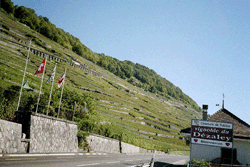
Dezaley
My safari started in the southwestern corner of Switzerland, the sterner, French-speaking region known as la Suisse romande . The extraordinary concentration of vineyards soaring above Lake Geneva lends this region its picturesque charm…not that such charm isn’t ubiquitous in this tiny, tidy country. Smallness of scale works to the wine’s favor here, as the soil and climatic conditions vary dramatically from one parcel to the next. Despite its size, the canton of Vaud has 28 appellations divided among its four wine-growing regions. I concentrated on the Lavaux region, specifically, the villages of Epesses, Saint-Saphorin, Dezaley, Cully, and Vevey-Montreux. By car these historic villages are but 5- 10 minutes apart and, as is true anywhere in Switzerland, all are attainable by rail.
Chasselas is the predominant grape here. “It’s an aromatically weak grape,” says Kurt Egli, Managing Director of Henri Badoux Wines, “so it’s more dependent on the wine-maker’s manipulation.” 85% of all Chasselas is grown in Switzerland and of that, c. 75% is grown in the Vaudois vineyards, rising steeply – in places as much as 68% – right from the shores of Lake Geneva. The steep inclines expose the vines to the sun, whose heat is enhanced by the solar reflection off the lake. Hard banks of “pudding stone”- a sand conglomerate bound into chalky soil – form the substratum and have been used to build the retaining walls that keep the soil for the vines in place. Strata of stone alternate with soft marl (a calcareous, clayey, sandy soil) to form the walls and narrow terraces, some no more than a yard wide.
You can make your headquarters in Lausanne or station yourself about 20 minutes outside the city in the beautiful and affordable Hotel Bon Rivage in La Tour-de-Peilz, which is quite literally a 10 minute walk from downtown Vevey, along the banks of Lake Geneva. The Bon Rivage is an insider secret: a marvelously run small hotel at decidedly unSwiss prices. Including the usual opulent Swiss breakfast, all taxes and services, and a stunning view of the lake, my large and comfortable room cost a mere 80 euros per night. And, if you’re over 65, there’s an extra 10% discount. It is possible to travel well in Switzerland and not spend a fortune!
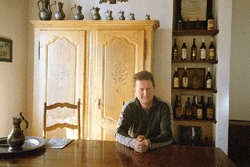
Winemaker Luc Massy
Leaving my hotel for a leisurely Sunday afternoon of local tasting rooms, I immediately ran across the “caveaux du vigneron” in each village and entered with the expectation of finding a tasting room; the name certainly translates to “winemaker’s cellar” in which one would expect that activity. Not so. The caveaux do offer wine but not for tasting and without any vigneron around. “It’s a problem, I know,” explains Luc Massy. “The general idea was to have local winemakers rotate and be on hand to offer samples and explanations?ow the caveaux are where locals can buy a glass at a good price, since the hotels are expensive.”
M. Massy will be familiar to readers of Philip Agee’s superb account of life in the Swiss military, Place de la Concorde Suisse (1983). Now, 20 years later, Luc Massy has taken over the family winery in Epesses and, with the confidence that he displayed in the earlier account, is not afraid to voice his opinion over the caveaux situation. “Of course,” he adds, “there are plenty of other places to have an authentic tasting experience.” He’s right.
One such opportunity lies just down the road in the neighboring village of Cully, at the aptly named Le Raisin, a small 5-star establishment whose knowledgeable and personable sommelier trained in Scotland! Nicolas Bourassin will organize and supervise a formidable tasting of regional wines?nd the Raison’s chef will match this with local dishes. Nicolas presented me with a sampling of Chasselas from neighboring villages; each was similar but not the same: one had more lime, another a bit more honey, another a strong almond character, yet another a tea-and-toast finish. “Chasselas totally shows up the most subtle differences in terroir ? Sauvignon Blanc or a Chardonnay would never show such a difference.”
But the real gem of the Lavaux region lies just adjacent to the Raisin in the ample and elegant Maison Rose, headquarters for Louis Bovard, whose family has operated a domain here for centuries. His wines have won international acclaim: Wine Spectator awarded his “romantically floral” Sauvignon Villette with a 90, the highest scoring white wine in that report. My own favorite is the Dezalay Medinette 2000, an intense Chasselas with a viscous, smoky edge to its crisp, mineral body. In fact, that tension between suave viscosity and tender acidity is what I love about Chasselas. In the hands of a master like Bovard, the results are fantastic. The Medinette displays a hint of honey and caramel around a flinty, herbaceous center. Dézaley, along with Calamin, are the only domains in the Vaud to have achieved grand cru status. In fact, the Dézaley vineyards, founded in the 12 th century by Cistercian monks, are thought to produce the ultimate Chasselas.
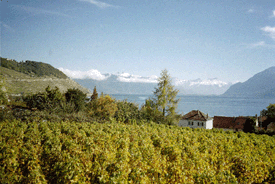
Swiss vineyards offer magnificent views of lakes and mountains
Reluctantly leaving the site of what has become one of my favorite whites, I traveled next to the Valais, specifically to Salquenen, aka Salgesch to its German-speaking population. Boasting some 40 wineries, this small village links the German-speaking Upper Valais with the French-speaking Lower Valais. Hence two names for the same town.
Highlight of my stay here was a hike through the vineyards from Salgesch to Sierre (Siders in German). I began in the well-appointed wine museum in Salgesch, marvelous in large measure through its Canadian-born director, Heidi Kunonen, who will explain all the antique wine-making apparatus. The Zumofenhaus in which the museum is housed is itself an antique, with portions dating to the 14 th century.
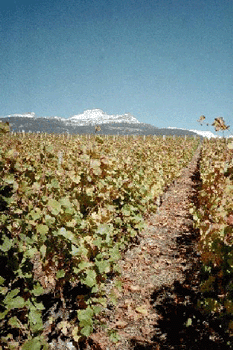
Bietschorn above Sierre, Switzerland
If you are at all interested in historical wine implements, methods of cultivation, soil analysis and subsoil geology, plan to spend several hours; of course you will need Heidi to translate the labels!
Leaving the museum, you now enter an open-air museum: the copiously documented wine path leading to the Chateau de Villa (and a sumptuous repast of the local specialty, raclette), at the other end. Along this 2-mile hike you will encounter a representative sampling of the various vines grown here. You’ll also find figs and dates, apricots and kiwi! It’s quite a sight to stand beneath a canopy of figs while looking out at a massive Alp. The anomaly of tropical fruit is due to the unique climate of the Valais, easily the driest and sunniest part of Switzerland. Carving out the Rhone valley, two massive alpine chains create a barrier that prevents humid air from entering and provides a channel for the foehn , a hot dry, desert-like wind that facilitates the late-autumn ripening of grapes and exotic fruits.
Salgesch is so enamored of its wine production that a visitor may even become vintner for a day, working alongside a local grower. Needless to say, English-only speakers should announce themselves well in advance. Along the wine path, I can recommend a visit to Charly and Patrick Wenger’s Cave Papillon to taste their Cornalin, a varietal unique to this canton. “Indeed,” says Charly, “Cornalin originated here in the Valais and genetic tests have shown that it is not related to any other varietal on the planet.” And it’s a lot of work. “Since the grapes require intense sun, they must not hang in the shade of the leaves: this means that each bundle must be bound up by hand, a labor-intensive process, as is their harvest. The grapes are very sensitive to pressure and only unbruised grapes can be used.” This violet gem of a wine is intense, robust, redolent of cherries and nutmeg?n ancient and venerable varietal, altogether wonderful and unforgettable.
Also unique to Valais is Humagne Rouge, frequently blended with other reds to add a musky note. Together with Pinot Noir, Cornalin, and Syrah, it makes up Le Tourmentin, a vigorous, fleshy red with clove and vanilla aromas over black currant and prune flavors. This is an original, local wine developed by the Rouvinez winery, which is a must-visit destination in Sierre. At Rouvinez you will find display cases with the soil samples in which each varietal is grown and, next to each case, a bottle of the relevant end product.
I was especially enamored of their Pinot Noir Colline de Geronde, a spicy concentration of flavors favoring black cherries and scorched earth. A heady and fantastic combination!
But even more spectacular at Rouvinez is a dessert wine with the appropriate name of Les Grains Nobles, a heady and fragrant mix of Marsanne and Pinot Gris, yielding a naturally sweet, complex, full-bodied wine with a raspberry and white truffle bouquet, and a luscious, softly unctuous finish. Chateau d’Yquem, watch out! As elsewhere, these dessert wines are the result of the Botrytis cinerea fungus, the “noble rot” that concentrates sugar content while consuming most of the grapes’ tartaric acid. But Valaisan dessert wines may carry the “Grain Noble” stamp only if they meet strict guidelines. The over-ripened grapes – which must attain at least 130 Oechsle before they are picked – must come from vines 15+ years old, additives to the must (chaptalization or inverse osmosis) are taboo, and the wines must spend a minimum 12 months in casks or barrels. Petite Arvine, Amigne, Malvoisie, Marsanne and Pinot Gris can all be vinified en liquoreux to produce marvelously mellow dessert wines.
But you must also experience Petite Arvine as a regular wine: at Rouvinez this would be their Chateau Lichten Blanc, a zesty, exuberant white unlike anything you’ve ever tried because of the salty taste (yes! salt) that underscores a grapefruit base while your nose finds wisteria and honeysuckle. Oh what marvelous sensory confusion as the opposing flavors play tag among your taste buds!
Of course you’ll also have to sample Dole, the emblematic red of the Valais, formerly comprised only of Pinot Noir and Gamay but now often nuanced by the addition of other local varietals such as DioliNoir or Garanoir. The blend must contain at least 85% Pinot Noir and Gamay, with Pinot predominant.
Time to move west and discover yet another unique wine venue, this one in a mountain village at the confluence of the Rhone and Vispe rivers, a village so perfect it appears fake.
VISP
With much of its medieval core still intact, Visp (pronounced Fisp) boasts both Europe’s oldest and highest tasting rooms. The former is located in an 11 th century structure, the Cave de la Tour in the Meier Turm or Meier Tower. To get there you climb cobble stone streets past the fabled 16 th century Im Eich Haus named for its architect/builder Nikolaus Im Eich. Above Visp lies Visperterminen, indeed a terminus: here, at 900 meters above sea level lies Europe’s highest tasting room. Fendant is the most common varietal here?rom the same grape known as Chasselas in the French-speaking cantons and Gutedel in the German-speaking ones. The Valais version tends to dry fruitiness.
But the real specialty here is resi or reze – a deliciously herbacious white with a citrus note lending piquant sprightliness – and Paien or Heida, aka the “pearl of alpine whites,” a truly rare and delicate wine. Smaller grapes mean concentrated sugars, which in turn give Heida its delicate bouquet of nut and honey over a base of exotic fruits. Derived from Sauvignon Blanc or Traminer grapes, Heida is grown only at this elevation and has, like the rarified alpine air in which it grows, a wisp of mineral crispness over a honey-hazelnut base. And it takes on a special flair when consumed at the St. Jodern Kellerei, Europe’s highest vineyard, rising 1150 meters above sea level. The tasting room is not far behind at 900 meters altitude, an amazing venue with spectacular views of the Alps. Perhaps the rarified air and lack of oxygen gives Heida its particular brilliance. This unusual white is, as you can tell, one my favorites.
Visp also has my best-in-its-price-category pick of restaurants: La Poste, where I enjoyed a succulent venison stew with spaetzle (strips of noodle dumpling) and the best baby Brussel sprouts I have eaten anywhere in the world! All this plus a glass of fine Merlot for an astonishing 13 SF (c. $10). La Poste also boasts 31 varieties of Cuban cigars!
TICINO
From Visp it’s a magnificent 4 hour train ride westward to the Ticino, through lush valleys from which the Alps fall back in staggered formation: dark, forest-furred slopes giving way to gently tufted lighter green escarpments which frame the final, craggy, white/gray summits. In German Switzerland the houses tend to be white or beige, often with ferocious, even atrocious, colors of trim: nefarious neon orange or purple is not uncommon. As soon as you enter the Ticino, houses wear Italian shades of ochre and salmon with delicate wrought-iron balconies sporting – can it be? – clothes out to dry.
This is a generally sunny, Mediterranean region, quite different in climate and ambience from the sterner (and usually colder) German and French regions. The Ticino abuts Italy and combines what is best about both countries: Italian warmth and lack of restraint coupled with Swiss cleanliness and order. La dolce vita is clearly in full swing – everyone smiles, gesticulates, welcomes visitors with open arms – yet the trains run on time, telephones work, and the streets are clean.
Ticino is Merlot country. Constituting some 85% of all production, the Merlot grape has made itself a home here and annually yields some of the most magnificent Merlots you will taste anywhere in the world: big, soft, velvety wines with formidable bouquets. And yet the wine industry almost died out here after massive infestations of phylloxera and mildew in the early 19 th century nearly wiped out all production. Of 8000 hectares (22,000 acres) of vineyard there remain but 1000 (2700 acres). Once viticulturists had figured out the problem they grafted American rootstock onto cuttings of “noble Merlot” imported from France. “Our aim is to work on superior ranges,” says Guido Brivio, President of Ticino Wine (2 cooperatives and 170 private vineyards). “With 6 million bottles per annum there’s no way we can compete at the lower end of the market.” Indeed, these are magnificent Merlots, characterized by a high level of olfactory complexity and great elegance, a far cry from the sometimes flabby and sickly-sweet product that passes for Merlot elsewhere. “We need to keep on trying,” adds Guido, because “Ticino is a wine-growing region waiting to be discovered.”
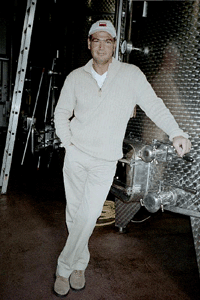
Guido Brevio
Guido’s winery is located about twenty minutes south of Lugano – and not even two hours north of Milan – in the region of Mendrisio, where you will find several superb sampling sites and a luncheon spot, Grotto Vallera, with a special twist.
It will take you all of ten minutes to drive from the Brivio winery to Tenimento dell’Or and on to Luigi Zanini, which is practically within walking distance of our lunch spot.
Tenimento dell’Or is an “ampelographic garden,” a wine laboratory where “we cultivate grape science,” says Meinrad Perler, the architect of this unusual experiment. Hundreds of rows of vines in complex combinations of cloning stretch out in neat rows bordered by roses. “Yes, decoration, certainly,” says M. Perler, “but they provide a lady-bug habitat and these in turn cut down on mildew and red spiders.” When he’s not tending his vines here M. Perler can be found cultivating soybeans deep in the heart of Texas. Winemakers in particular should not miss an opportunity to visit.
The Zanini winery is typically Swiss with an equal nod to efficiency and tradition: next to rooms gleaming with high tech consoles you’ll find giant wooden vats, open at the top, which are the traditional way to age red wines here. The tasting room opens onto a grand oval hall, shaped and tiered like a football field, with row upon row of barrels (700 in all), dramatically lit from below. An amazing sight and worthy of contemplation as you sip the noble 2000 Vinattieri with its deep aroma of ripe cherries and cured tobacco. After sampling some more gorgeous Merlots , we all repaired to Grotto Vallera for lunch.
While the word conjures visions of subterranean damp with cobwebs and perhaps a tomb or two, a grotto in the Ticino refers specifically to a restaurant with covered, outdoor dining. Usually there’s a grape arbor and a fountain, rustic tables, benches, shade, and local fare enjoyed by a local clientele.
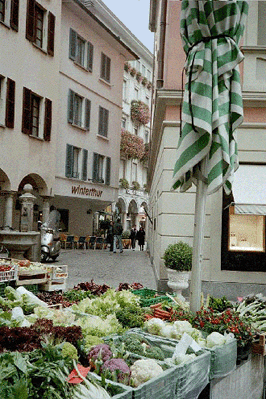
Farmers’ Market in downtown Lugano
Our host came to introduce himself? was astonished at his fluent English and evident familiarity with America. “That’s because I’ve spent time in New York,” says Franco Buzzi. “Remember Laugh-In? Well, my cousin is Ruth Buzzi.” None of the Swiss in our little party had any idea why this fact alone was pretty hilarious: finding Ruth Buzzi’s cousin in rural Switzerland. The humor is clearly a genetic trait, since Franco kept up an amusing and informative line of patter about the food and the region. By the way, the local pronunciation is bootzee .
At Grotto Vallera I enjoyed a meal entirely comprised of local dishes. We began with an antipasto di salume , an array of homemade patés, salamis, and a house specialty with the truly unfortunate name of lardo . This turned out to be wafer-thin shavings of a pure white melt-in-your-mouth lard (also a delicacy in neighboring Piemonte, Italy). Then came a creamy, fragrant polenta with lean, savory sausages (you can’t think in terms of sausage links or franks?hese are complex, multi-textured, meaty tubes of pork/veal/truffle flavored heartiness) and onions. A simple, mouth-filling, mellow house-Merlot rounded out this meal which cost less than $12. Grotto Vallera is open seven days a week, all year long, but you should call ahead “just in case,” says Franco. There’s a local train to/from Lugano every hour and you can walk from the station. “If it’s raining, I’ll come pick you up,” he adds.
If you are headed north to Neuchatel, you’ll want to stop at the Hotel Bellevue, run by the husband-and-wife team of Nicolas Schorderet and Mary-Laure Denervaud. Mary-Laure produces exquisite cuisine, while Nicolas will wax eloquent – in English – over his well-stocked cellar. The Hotel Bellevue is situated in a 17 th century edifice at the southern tip of Lake Neuchatel near Yverdon les Bains, a noted hot spring. Nicolas will custom-design your stay here to include a thermal bath at Yverdon, a carriage ride through the local vineyards, a visit to an organic winery, and of course an informative tasting session in his well-appointed cellar. If you are traveling by train, he will provide transportation to and from the station.
The designated driver in your party should sample the national Swiss non-alcoholic beverage: Rivella, a soft drink made from whey! This cheese by-product is mixed with sugar and carbonated water to yield an amber-colored malty/milky concoction which is, of course, much healthier than cola and, for many palates, tastier too.
HELPFUL INFORMATION:
Country code for Switzerland is 41; if calling from overseas, drop the 0 in front of numbers.
SWISS (it’s just that, not Swiss Air), the new national airline, has special promotions; there is daily non-stop service to Zurich from Los Angeles.
Swiss Rail passes are good for ALL modes of transport including local buses, trams, subways.
VAUD
Bon Rivage, Route de St-Maurice 18, CH – 1814 La Tour-de-Peilz. www.bon-rivage.ch .
Melia Carlton, 4 Avenue de Lour, 1007 Lausanne, tel. 021 613 0707, www.solmelia.com; melia.calrlton@solmelia.com . A “boutique” hotel of the sort you might find in New York’s Soho: small, efficient, very modern with excellent staff and a good location. For some reason, breakfast is included only if you ask for it to be when making your reservation; don’t forget, it’s worth it.
Chateau d’Aigle, CH-1860 Aigle. www.chateauaigle.ch . info@chateauaigle.ch
Henri Badoux Vins, Avenue du Chamossaire 18, CH-1860 Aigle. www.badoux.com , badoux.vins@bluewin.ch
Le Raisin, 1 Place de l’Hotel-de-Ville, CH-1096 Cully. www.relaischateaux.com/raisin
Nicolas Bourassin, sommelier: NBourassin@hotmail.com
Domaine Louis Bovard, La Maison Rose, CH-1096 Cully, tel. 021 799 2125; vin@domainebovard.com
A La Pomme de Pin, Rue Cite-Derriere 11-13, 1005 Lausanne, tel. 021 323 4656. Try the specialty, omble chevalier, a delicious freshwater fish from the Lake Geneva.
Le Verre a Pied (Caveau-Oenotheque), Rue Saint-Laurent 9, CH-1003 Lausanne, tel 021 323 0133. Over 200 selections featuring vaudois and valaisan wines?nd local meat and cheese delicacies?o arrange a private tasting write ahead: chantal.jacquemet@bluemail.ch
VALAIS
Cave Papillon, Cinastrasse 39, 3970 Salgesch, www.cave-papillon.ch
Rouvinez Vins, Colline de Geronde, 3960 Sierre, www.rouvinez.com
Arkanum Hotel – reasonable: prices start at c. 100SF for a single room which includes the customary lavish breakfast; as with many Swiss hotels, dogs are permitted at a rate of 7SF per night “without Kibbel.” There’s even a room with a giant cask fitted out as a bed! www.hotelarkanum.ch
St. Jodern Kellerei, 3932 Visperterminen, www.jodernkeller e i.ch
Cave de la Tour, Treichweg 6, 3930 Visp, tel. 027 946 5707, cavedelatour@rhone.ch
Restaurant La Poste, 3930 Visp, tel. 027 948 3388, www . la-poste-v i sp.ch
Ticino
Hotel Pestalozzi, Piazza Indipendenza 9, 6901 Lugano, tel. 091 921 4646, www.attuale.com/pestalozzi. html .
This is a real find: centrally located, clean, and exceedingly reasonable rates: with breakfast, singles are 92 SF including breakfast!
Hotel Principe Leopoldo, Via Montalbano, 6900 Lugano, tel. 091 985 8855, www.leopoldohotel.com
Another link in the relais & chateaux chain?nother superb wine tasting venue. The aptly named Gabriele Superiore, sommelier extraordinaire, will oversee any sampling you may want to do and can organize a superb tasting of local wines.
I Vini di Guido Brivio, Via Vignoo 8, 6850 Mendrisio, tel. 4191/646 0757, www.brivio.ch
Tenimento dell’Or, 6864 Arzo, tel. 4191/646 74 02
Vinattieri Ticinesi, 6853 Ligornetto, tel. 4191/647 33 33, www.zanini.ch
Vine & Wine Museum, Maison Zumofen, 3970 Salgesch, www.museeva l aisanduvin.ch ; weinmuseum@bluewin.ch
& & &
